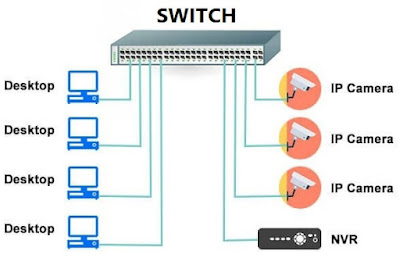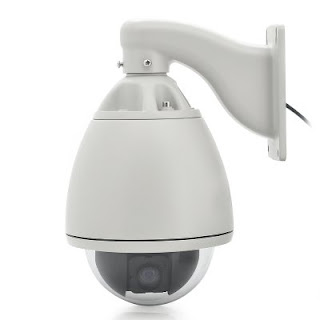360 degrees of protection with the dome security camera
Pan/Tilt/Zoom cameras or PTZ cameras or 360degree cameras remain
critical parts of many surveillance systems, especially in large security
operations. Because of this it is important to understand and consider the key
elements in selecting and using PTZ cameras.
In this guide we cover the basics of PTZ cameras and their selection,
including:
- Pan/tilt/zoom
basic terms
- Zoom
ratios explained
- Using
angle of view instead of zoom rating
- E-flip
examined
- Available
PTZ resolutions and their advantages/disadvantages
- Form
factor selection (speeddomes, mini PTZs, positioners)
- Integrated
IR PTZs
- PTZ
lens issues
- Actual
versus effective PPF
- Presets
and tours
- Common
applications
Pan/Tilt/Zoom Camera Basics
PTZs combine a camera with a motorized mechanism which allows it to move
in multiple directions. These movements are referred to as:
- Pan: Left/right horizontal
movement
- Tilt: Up/down vertical
movement
- Zoom: Near and far
This example demonstrates each of these movements:
Note that the extent to which cameras may be moved varies. Some models
may be limited to 340° panning, some may tilt above horizontal, and zoom levels
may vary from only slight magnification to extremely long distance. These specs
depend on the type of PTZ (detailed below) and individual manufacturer/model.
E-Flip
Many PTZs include a feature called "E-flip" which
automatically rotates the camera 180° when the operator is following a subject
directly beneath it. This is a more intuitive control method than models which
do not include E-flip, as the user must manually rotate the camera to follow
the subject as they pass below.
This example shows the camera flipping as it is tilted down to 0° and
beyond, while only the down tilt control is pressed.
Zoom Ratio
Manufacturers most often advertise PTZs using their optical zoom ratio,
e.g., 18x, 26x, 36x, etc. This ratio is formed simply by dividing the camera's
maximum focal length by its minimum, such as:
Use View Angle Instead
However, using only zoom ratio as an indicator of PTZ zoom performance
misses some key details. Since lenses have differing wide/telephoto focal
lengths, two cameras with the same ratio may have very different fields of
view.
For example, looking
at the specs of two 18x zoom cameras, we can see that one has a telephoto angle
of view ~30% narrower (and thus higher PPF) than the other due to varying lens
specs. But the reverse is also true, with the camera on the right having a
wider possible angle of view, which may be more useful in some applications.
Users must beware of these issues when selecting PTZs and choose based
on their required areas of interest.
Ignore Digital Zoom
Some PTZ models include digital zoom in addition to optical, even
in some cases multiplying the two to create a deceptive "total zoom"
figure, such as this camera:
However, digital zoom is a "fake" zoom, not providing
additional details, only enlarging pixels captured and these specs should
effectively be ignored in favor of angle of view as discussed above.
Resolutions Available
PTZs are now available in varying HD resolutions, as well as standard
definition. Historically, zoom lenses for megapixel cameras were not available,
though in the past few years, 1080p PTZs with 36x zoom have become readily
available.
Note that HD is not necessarily preferable in PTZ applications, due
to flaws in long focal length megapixel lenses, detailed later in this report.
PTZ Form Factors
There are three typical types of PTZ camera in use today, with different
strengths and weaknesses, overviewed in this chart and detailed below:
Speeddome
The most common type of PTZ in use is the speeddome, which packages the
camera/lens and pan/tilt mechanism in a dome form factor, typically 8-10"
in diameter.
Speeddomes have several advantages:
- Pre-packaged: Due to their
construction, speeddomes typically require less work to mount than
positioning systems (below), and may be mounted in a variety of locations.
Wall, pendant, recessed ceiling, and other mounts are all readily
available.
- Integrated
IR available: Several
manufacturers now offer speeddomes with integrated IR (detailed further
below), which greatly improves their usefulness in low light, as
speeddomes historically have used relatively high F-Stop lenses,
poor in dark scenes.
- Fast
PTZ speeds: Speeddomes
are the fastest movable cameras available. Speeds over 300º per second are
not uncommon, and over 400º per second is not unheard of. This allows
tracking of faster-moving subjects, and shorter movement times when
switching between presets, often a fraction of a second.
- Pan/tilt
range: Speeddomes
typically feature full 360º pan range, without stops, and 180º tilt range
with e-flip, to allow trailing of subjects as they move beneath the
camera. Many cameras have extended tilt beyond 90º, with some
offering up to 15º of up-tilt, above the horizon. Up-tilt previously
required a pan/tilt positioner.
- Less
wind loading: Compared
to pan/tilt positioning systems, reviewed below, speeddomes do not have as
many issues in strong winds, which may cause vibration in pan/tilt
cameras.
Mini PTZ
Mini PTZ domes are a relatively recent development, with several
manufacturers now offering models. These smaller PTZs have two key advantages:
- Low
cost: Mini
PTZs are must less expensive than full size speeddomes, often ~$300 USD or
less, compared to $800-2000 for a speeddome.
- Small
size: These
models are much smaller than typical speeddomes, close to the size of a
typical fixed dome camera (5-6" diameter) and much smaller in height.
However, there are disadvantages to mini PTZs as well:
- Limited
zoom: Mini
PTZs are typically limited to low optical zoom ratios such as 3x, though
some may be found up to ~10x. Compared to other PTZs, often 30x or more,
this is very low.
- Limited
positioning range: Mini PTZs typically do not include full
360° panning, nor e-flip found in speeddomes.
- Slow
pan/tilt speed: Panning
speed of a mini PTZ is typically very low, 30-90 degrees per second, a
fraction of speeddome panning speed.
Pan/Tilt Positioners
Pan/tilt positioners are the oldest type of movable camera system,
available prior to integrated PTZ speeddomes. These systems historically
consisted of separate componentes which were manually integrated: the
positioner itself, a separate camera, and zoom lens.
However, some manufacturers now offer pre-packaged IP positioning
systems, such as the Axis Q86/Q87 and Pelco Esprit.
The key advantage to pan/tilt positioners is flexibility. Users may
choose from multiple cameras and zoom lenses, instead of being limited to
available speeddome options. This is useful when extremely long-range zoom
lenses are required, as lenses over 100x zoom are available.
Positioners were previously the only option when infrared
illuminators were desired in a PTZ camera. However, speeddomes with integrated
IR have now largely caught up, offering long range infrared.
There are two key drawbacks to positioners:
- PTZ
speed: Positioners
often have low pan/tilt speeds, due to the weight and balance of cameras
mounted on them. Increasing speeds could lead to increased vibration and
"bounce" as cameras started and stopped moving, making tracking
more difficult.
- Wind
loading: Due
to their increased profile, positioning systems in exposed areas may
suffer from vibration due to wind, which is reduced or not present when
using speeddomes.
Integrated IR Speeddomes
One recent advance in PTZ speeddomes is the addition of integrated IR,
previously mainly found in positioners only. Many manufacturers now offer
integrated IR speeddomes, such as Bosch, Dahua, Hikvision, and Samsung.
Integrated IR speeddomes have outperformed non-IR models in our
tests at all ranges, with illumination at 450' and beyond. For example, the
comparison below shows a 1080p IR PTZ versus a non-IR model at ~485' distance,
with the subject clearly displayed in the IR model. The non-IR PTZ displays
only noise, no usable image.
PTZ Lens Issues
When planning PTZ camera use, users should be aware that PTZ and other
long focal length lenses do not resolve images the same as shorter focal length
lenses, resulting in a reduction in practical details delivered. Because
of this, when calculating needed PPF using PTZ cameras, users should expect a
~50% or higher reduction in delivered details.
For example, the image below shows a subject at ~420' using a 1080p
camera, in an 87 PPF scene. However, details delivered are similar to ~35-40
PPF, less than half of actual.
Note that SD PTZs do not suffer typically suffer from these effects. For
example, the VGA PTZ below displays a better image than the 1080p model at the
same range, despite its much lower actual PPF.
PTZ Presets and Tours
In order to make PTZ operation easier, these cameras include the option
to define predetermined positions, called "presets", which may be
used to quickly move the camera to a specific position. For example, the clip
below shows several presets covering a parking lot, quickly called in
succession using a VMS.
In addition to presets, PTZs include tours (also called patterns) which
move the camera automatically on a preset time schedule (typically every 3-10
seconds). Tours in current cameras most often call presets in a specific
order (called a preset tour).
However, in the past, tours were typically defined by recording an
operator manually moving the camera. This style of tour has generally fallen
out of favor, though, as it becomes more difficult to spot small objects in
motion as the camera is moving, and the constant PTZ movement precludes the use
of camera-side video motion detection, which may be used in preset tours.
Most Common PTZ Applications
For the most part, PTZ usage is dropping in favor of fixed megapixel
cameras, but there are still applications in which they are frequently used.
- Live
monitoring operations: In systems with surveillance operators,
PTZs are still often used, as they allow the user to more closely inspect
and follow subjects than is possible with fixed cameras. Live monitoring
is most often used in larger, higher security systerms, such as airports,
critical infrastructure, city surveillance, etc., though many large
retailers also employ PTZs and operators.
- Large
areas: In
very large areas, PTZs on preset patterns are still sometimes used
instead of fixed megapixel cameras due to the higher details they may
deliver at long range. For example, the image below compares 4K and 5MP
cameras against HD and SD PTZs, with even the lowest resolution PTZ
delivering details of the subject at this range:




























